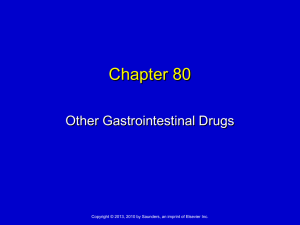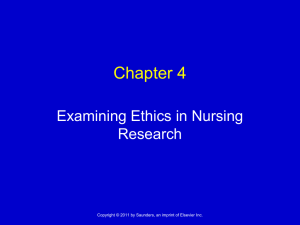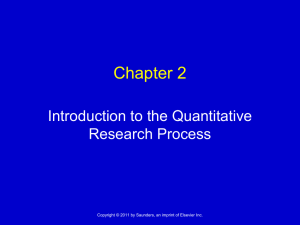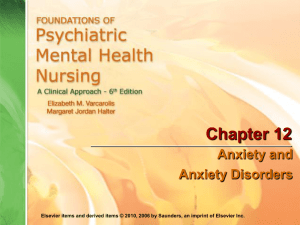Chapter_013
advertisement
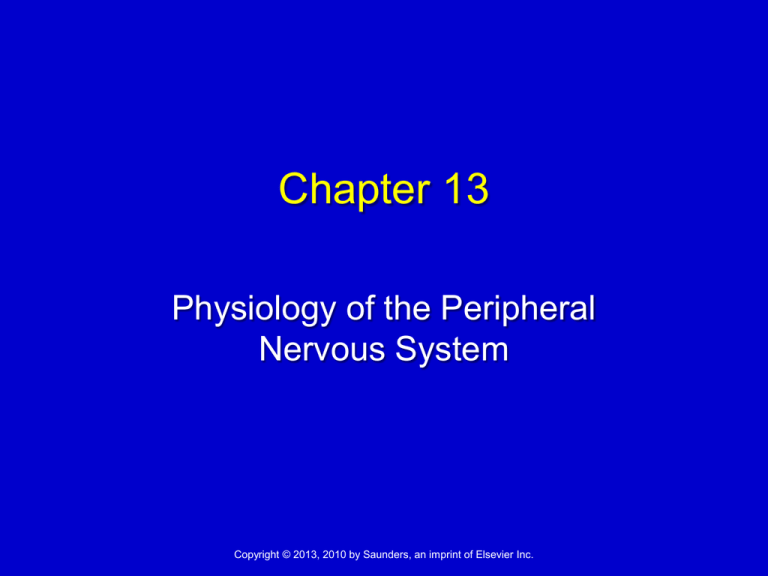
Chapter 13 Physiology of the Peripheral Nervous System Copyright © 2013, 2010 by Saunders, an imprint of Elsevier Inc. Physiology of the Peripheral Nervous System Divisions of the nervous system Overview of autonomic nervous system functions Basic mechanisms by which the autonomic nervous system regulates physiologic processes Anatomic considerations Introduction to neurotransmitters of the peripheral nervous system Copyright © 2013, 2010 by Saunders, an imprint of Elsevier Inc. 2 Physiology of the Peripheral Nervous System Introduction to receptors of the peripheral nervous system Exploring the concept of receptor subtypes Locations of receptor subtypes Functions of cholinergic and adrenergic receptor subtypes Receptor specificity of adrenergic neurotransmitters Neurotransmitter life cycles Copyright © 2013, 2010 by Saunders, an imprint of Elsevier Inc. 3 Divisions of the Nervous System Central nervous system Brain and spinal cord Peripheral nervous system Somatic motor Autonomic (ANS) • Parasympathetic • Sympathetic Copyright © 2013, 2010 by Saunders, an imprint of Elsevier Inc. 4 Overview of Autonomic Nervous System Functions Three principal functions Regulate the heart Regulate secretory glands (salivary, gastric, sweat, and bronchial) Regulate smooth muscles (bronchi, blood vessels, urogenital system, and GI tract) Copyright © 2013, 2010 by Saunders, an imprint of Elsevier Inc. 5 Parasympathetic Nervous System Seven regulatory functions Slowing the heart rate Increasing gastric secretions Emptying the bladder Emptying the bowel Focusing the eye for near vision Constricting the pupil Contracting bronchial smooth muscle Copyright © 2013, 2010 by Saunders, an imprint of Elsevier Inc. 6 Parasympathetic Nervous System Parasympathetic nervous system (PNS) drugs Digestion of food Excretion of waste Control of vision Conservation of energy Copyright © 2013, 2010 by Saunders, an imprint of Elsevier Inc. 7 Sympathetic Nervous System Functions Three main functions 1. Regulation of cardiovascular system • Maintaining blood flow to the brain • Redistributing blood • Compensating for loss of blood Copyright © 2013, 2010 by Saunders, an imprint of Elsevier Inc. 8 Sympathetic Nervous System Functions Three main functions (cont’d): 2. Regulation of body temperature • Regulates blood flow to the skin • Promotes secretion of sweat • Induces piloerection (erection of hair) Copyright © 2013, 2010 by Saunders, an imprint of Elsevier Inc. 9 Sympathetic Nervous System Functions Three main functions (cont’d): 3. Implementation of “fight-or-flight” reaction • Increasing heart rate and blood pressure • Shunting blood away from the skin and viscera • Dilating the bronchi • Dilating the pupils • Mobilizing stored energy Copyright © 2013, 2010 by Saunders, an imprint of Elsevier Inc. 10 Homeostatic Objectives of SNS Maintenance of blood flow to the brain Redistribution of blood flow during exercise Compensation for loss of blood, primarily by causing vasoconstriction SNS = sympathetic nervous system. Copyright © 2013, 2010 by Saunders, an imprint of Elsevier Inc. 11 SNS Body Temperature Regulation Regulates blood flow to the skin Dilating surface vessels: accelerates heat loss Constricting cutaneous vessels: conserves heat Promotes secretion of sweat glands: helps the body cool Induces piloerection: promotes heat conservation Copyright © 2013, 2010 by Saunders, an imprint of Elsevier Inc. 12 Fight-or-Flight Response Increasing heart rate and blood pressure Shunting blood away from the skin/viscera and into skeletal muscle Dilating the bronchi to improve oxygenation Dilating the pupils Mobilizing stored energy, thereby providing glucose for the brain and fatty acids for the muscles Copyright © 2013, 2010 by Saunders, an imprint of Elsevier Inc. 13 Sympathomimetic Drugs Primarily used for effects on the Heart and blood vessels • Hypertension, heart failure, angina pectoris Lungs • Primarily asthma Copyright © 2013, 2010 by Saunders, an imprint of Elsevier Inc. 14 Basic Mechanisms by Which ANS Regulates Physiologic Processes Patterns of innervation and control Feedback regulation Autonomic tone ANS = autonomic nervous system. Copyright © 2013, 2010 by Saunders, an imprint of Elsevier Inc. 15 Basic Mechanisms by Which ANS Regulates Physiologic Processes Patterns of innervation and control Dual innervation opposed: heart rate Dual innervation complementary: erection and ejaculation Only one division: blood vessels Copyright © 2013, 2010 by Saunders, an imprint of Elsevier Inc. 16 Fig. 13-1. Opposing effects of parasympathetic and sympathetic nerves. Copyright © 2013, 2010 by Saunders, an imprint of Elsevier Inc. 17 Basic Mechanisms by Which ANS Regulates Physiologic Processes Feedback regulation Baroreceptor reflex and blood pressure Feedback loop Sensor, effector neurons Copyright © 2013, 2010 by Saunders, an imprint of Elsevier Inc. 18 Fig. 13-2. Feedback loop of the autonomic nervous system. Copyright © 2013, 2010 by Saunders, an imprint of Elsevier Inc. 19 Basic Mechanisms by Which ANS Regulates Physiologic Processes Autonomic tone Only one division provides basal control to organ. • Most organs: predominant tone is PNS • Vascular system: predominant tone is SNS Copyright © 2013, 2010 by Saunders, an imprint of Elsevier Inc. 20 Anatomic Considerations Parasympathetic nervous system Sympathetic nervous system Somatic motor system Copyright © 2013, 2010 by Saunders, an imprint of Elsevier Inc. 21 Fig. 13-3. The basic anatomy of the parasympathetic and sympathetic nervous systems and the somatic motor system. Copyright © 2013, 2010 by Saunders, an imprint of Elsevier Inc. 22 Sympathetic Nervous System Neurons Preganglionic neurons Postganglionic neurons Medulla of the adrenal gland Functional equivalent of the postganglionic SNS neuron Copyright © 2013, 2010 by Saunders, an imprint of Elsevier Inc. 23 Sympathetic Nervous System Two general sites of action Synapses: preganglionic/postganglionic Junction: postganglionic neurons/effector organs Copyright © 2013, 2010 by Saunders, an imprint of Elsevier Inc. 24 Neurotransmitters of the Peripheral Nervous System Acetylcholine • Employed at most junctions of the peripheral nervous system Norepinephrine • Released by most postganglionic neurons Epinephrine • Released by the adrenal medulla Copyright © 2013, 2010 by Saunders, an imprint of Elsevier Inc. 25 Fig. 13-4. Transmitters employed at specific junctions of the peripheral nervous system. Copyright © 2013, 2010 by Saunders, an imprint of Elsevier Inc. 26 Receptors of the Peripheral Nervous System Cholinergic receptors Adrenergic receptors • Mediated by acetylcholine • Mediated by epinephrine and norepinephrine Two basic categories of receptors Copyright © 2013, 2010 by Saunders, an imprint of Elsevier Inc. 27 Receptors of the Peripheral Nervous System Subtypes of cholinergic and adrenergic receptors • Subtypes of cholinergic receptors • NicotinicN • NicotinicM • Muscarinic • Subtypes of adrenergic receptors • Alpha1 • Alpha2 • Beta1 • Beta2 • Dopamine Copyright © 2013, 2010 by Saunders, an imprint of Elsevier Inc. 28 Fig. 13-5. Drug structure and receptor selectivity. Copyright © 2013, 2010 by Saunders, an imprint of Elsevier Inc. 29 Exploring the Concept of Receptor Subtypes What do we mean by the term receptor subtype? How do we know that receptor subtypes exist? How can drugs be more selective than natural neurotransmitters at receptor subtypes? Why do receptor subtypes exist? Do receptor subtypes matter to us? You bet! Copyright © 2013, 2010 by Saunders, an imprint of Elsevier Inc. 30 Locations of Receptor Subtypes Knowledge of the sites at which specific receptor subtypes are located will help predict which organs a drug will affect. Copyright © 2013, 2010 by Saunders, an imprint of Elsevier Inc. 31 Classification of Cholinergic and Adrenergic Receptors Cholinergic Receptors • Mediated by acetylcholine Adrenergic Receptors • Mediated by epinephrine and norepinephrine Copyright © 2013, 2010 by Saunders, an imprint of Elsevier Inc. 32 Functions of Cholinergic and Adrenergic Receptor Subtypes Functions of cholinergic receptor subtypes Activation of nicotinicN (neuronal) receptors Activation of nicotinicM (muscle) receptors Activation of muscarinic receptors Copyright © 2013, 2010 by Saunders, an imprint of Elsevier Inc. 33 Fig. 13-6. Locations of cholinergic and adrenergic receptor subtypes. Copyright © 2013, 2010 by Saunders, an imprint of Elsevier Inc. 34 Functions of Adrenergic Receptor Subtypes Alpha1 Vasoconstriction Ejaculation Contraction of bladder neck and prostate Alpha2 Located in presynaptic junction Minimal clinical significance Copyright © 2013, 2010 by Saunders, an imprint of Elsevier Inc. 35 Functions of Adrenergic Receptor Subtypes Beta1 Heart Increases • Heart rate • Force of contraction • Velocity of conduction in atrioventricular (AV) node Kidney Renin release Copyright © 2013, 2010 by Saunders, an imprint of Elsevier Inc. 36 Functions of Adrenergic Receptor Subtypes Beta2 Bronchial dilation Relaxation of uterine muscle Vasodilation Glycogenolysis Dopamine Dilates renal blood vessels Copyright © 2013, 2010 by Saunders, an imprint of Elsevier Inc. 37 Receptor Specificity of the Adrenergic Neurotransmitters Epinephrine can activate all alpha and beta receptors, but not dopamine receptors. Norepinephrine can activate alpha1, apha2, and beta1 receptors, but not beta2 or dopamine receptors. Dopamine can activate alpha1, beta1, and dopamine receptors. Note: Dopamine is the only neurotransmitter capable of activating dopamine receptors. Copyright © 2013, 2010 by Saunders, an imprint of Elsevier Inc. 38 Neurotransmitter Life Cycles Many drugs produce their effects by interfering with specific life cycles. Life cycle of acetylcholine Life cycle of norepinephrine Life cycle of epinephrine Copyright © 2013, 2010 by Saunders, an imprint of Elsevier Inc. 39 3 Fig. 13-7. Life cycle of acetylcholine. Note that transmission is terminated by enzymatic degradation of ACh and not by uptake of intact ACh back into the nerve terminal. (Acetyl CoA = acetylcoenzyme A, ACh = acetylcholine, AChE = acetylcholinesterase.) Copyright © 2013, 2010 by Saunders, an imprint of Elsevier Inc. 40 Fig. 13-8. Life cycle of norepinephrine. Note that transmission is terminated by reuptake of NE into the nerve terminal and not by enzymatic degradation. Note also the structural similarity between epinephrine and norepinephrine. (DA = dopamine, MAO = monoamine oxidase, NE = norepinephrine.) Copyright © 2013, 2010 by Saunders, an imprint of Elsevier Inc. 41
